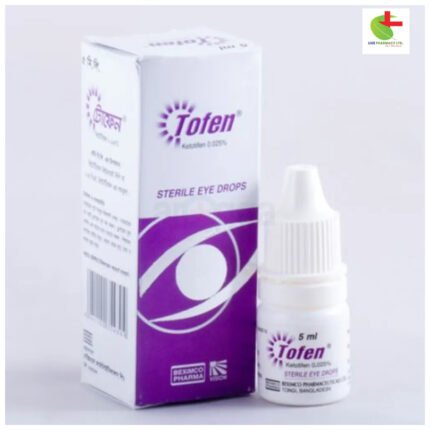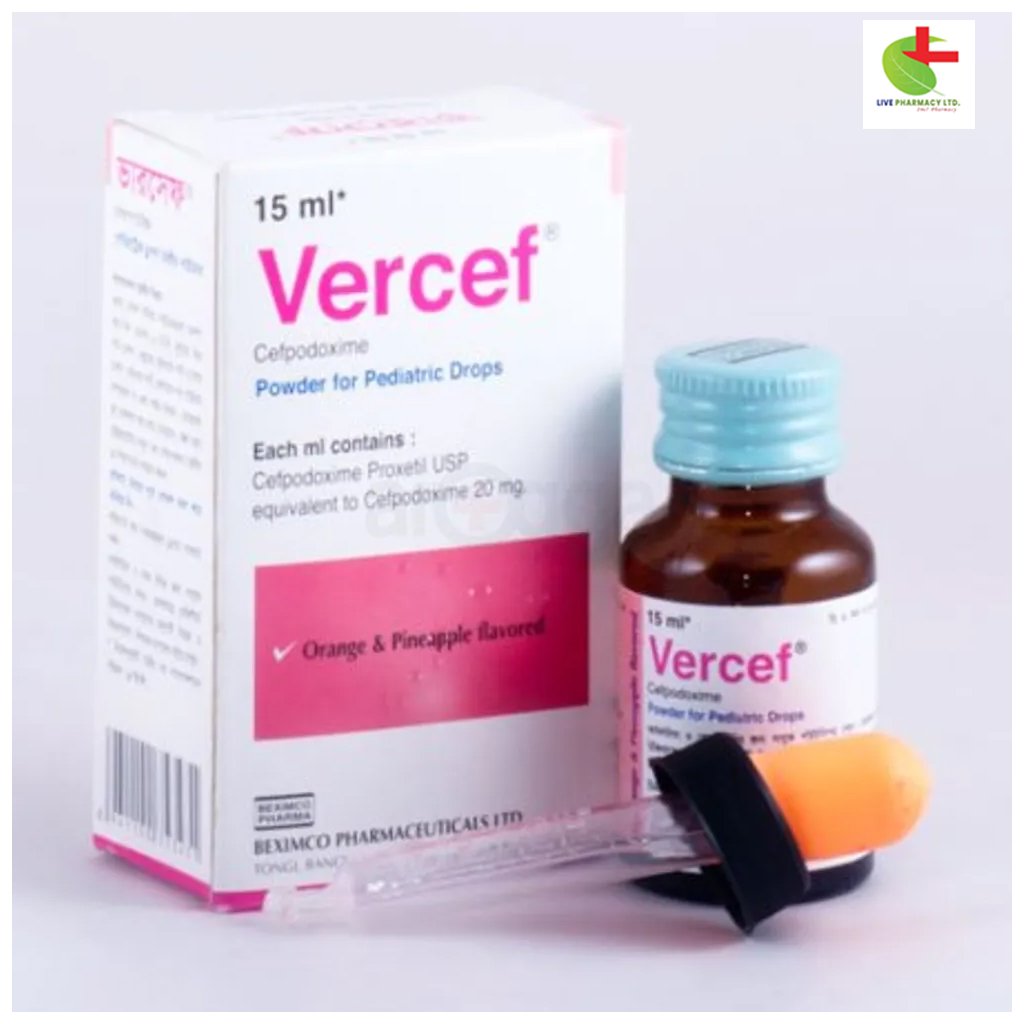

Vercef Pediatric Drops
60.00৳ Bottle (15 ml)
- Vercef is a third-generation cephalosporin effective against a range of bacterial infections including otitis media, sinusitis, pneumonia, and urinary tract infections.
- It covers both Gram-positive and Gram-negative bacteria, including those resistant to beta-lactamases.
- Suitable for adults, adolescents, and pediatric patients.
- Provides reliable treatment with minimal side effects when used as directed by a healthcare provider.
 Brand
Brand
|
Beximco Pharmaceuticals Ltd |
|---|---|
 Generics
Generics
|
Cefpodoxime Proxetil |
 Type
Type
|
Paediatric Drop |
Indications
Vercef is prescribed for the treatment of infections caused by susceptible bacteria, including:
- Acute Otitis Media: Effective against Streptococcus pneumoniae, Streptococcus pyogenes, Haemophilus influenzae, and Moraxella catarrhalis (including beta-lactamase producing strains).
- Pharyngitis/Tonsillitis: Treats infections caused by Streptococcus pyogenes.
- Acute Maxillary Sinusitis: Targets Haemophilus influenzae (including beta-lactamase producing strains), Streptococcus pneumoniae, and Moraxella catarrhalis.
- Community-Acquired Pneumonia: Effective against S. pneumoniae or H. influenzae (including beta-lactamase-producing strains).
- Acute Bacterial Exacerbation of Chronic Bronchitis: Treats infections caused by S. pneumoniae, H. influenzae (non-beta-lactamase-producing strains), or M. catarrhalis.
- Skin and Skin Structure Infections: Addresses infections caused by Staphylococcus aureus and Streptococcus pyogenes.
- Uncomplicated Urinary Tract Infections: Effective against E. coli, Klebsiella pneumoniae, Proteus mirabilis, and Staphylococcus saprophyticus.
- Uncomplicated Gonorrhea: Treats Neisseria gonorrhoeae (including penicillinase-producing strains).
- Rectal Gonococcal Infections in Women: Effective against Neisseria gonorrhoeae (including penicillinase-producing strains).
Pharmacology
Vercef, a third-generation cephalosporin, provides robust coverage against both Gram-positive and Gram-negative bacteria. As a prodrug, it is converted into its active form, Cefpodoxime, and is highly resistant to beta-lactamases. Approximately 29-33% of Cefpodoxime is excreted unchanged in the urine within 12 hours. Vercef is especially effective against beta-lactamase producing strains and various bacteria, including E. coli, S. aureus (including penicillinase-producing strains), and Neisseria gonorrhoeae.
Dosage & Administration
Adults and Adolescents (13 years and older):
- Pharyngitis/Tonsillitis: 100 mg every 12 hours for 5 to 10 days.
- Acute Maxillary Sinusitis: 200 mg every 12 hours for 10 days.
- Community-Acquired Pneumonia: 200 mg every 12 hours for 14 days.
- Acute Bacterial Exacerbation of Chronic Bronchitis: 200 mg every 12 hours for 10 days.
- Skin and Skin Structure Infections: 400 mg every 12 hours for 7 to 14 days.
- Uncomplicated Urinary Tract Infections: 100 mg every 12 hours for 7 days.
- Uncomplicated Gonorrhea: Single dose of 200 mg.
- Rectal Gonococcal Infections in Women: Single dose of 200 mg.
Infants and Pediatric Patients (2 months to 12 years):
- Acute Otitis Media: 5 mg/kg body weight every 12 hours for 5 days.
- Pharyngitis/Tonsillitis: 5 mg/kg body weight every 12 hours for 5 to 10 days.
- Acute Maxillary Sinusitis: 5 mg/kg body weight every 12 hours for 10 days.
Special Populations:
- Renal Dysfunction: Increase dosing intervals to 24 hours for severe renal impairment (creatinine clearance <30 ml/min).
- Liver Cirrhosis: No dose adjustment needed.
Always use Vercef as directed by your healthcare provider.
Interactions
- Antacids: High doses may reduce peak plasma levels and absorption of Cefpodoxime.
- Probenecid: May increase Cefpodoxime levels by approximately 31%.
- Nephrotoxic Drugs: Monitor renal function closely when used with nephrotoxic drugs.
Contraindications
Vercef is contraindicated for individuals with known allergies to Cefpodoxime or other cephalosporins.
Side Effects
Common side effects include diarrhea, nausea, fungal infections (skin and vaginal), abdominal pain, headache, chest pain, myalgia, dyspepsia, dizziness, and cough. Fungal skin rashes are more common in children.
Pregnancy & Lactation
Cefpodoxime has not shown teratogenic effects in animal studies, but use during pregnancy should be limited to clearly needed cases. Cefpodoxime is excreted in breast milk; consider whether to discontinue breastfeeding or the medication.
Precautions & Warnings
In patients with reduced urinary output or renal insufficiency, reduce the total daily dose. Use caution with potent diuretics. Prolonged use may lead to overgrowth of non-susceptible organisms.
Therapeutic Class
Third-generation Cephalosporins
Reconstitution
To prepare a 50 ml suspension, add 30 ml of cooled, boiled water to the dry mixture. Shake well after each addition. Store the reconstituted suspension in a cool, dry place or refrigerator and discard any unused portion after 14 days.
Storage Conditions
Store in a dry place, away from light and heat. Keep out of reach of children.











Reviews
There are no reviews yet.